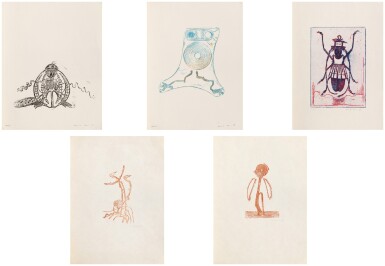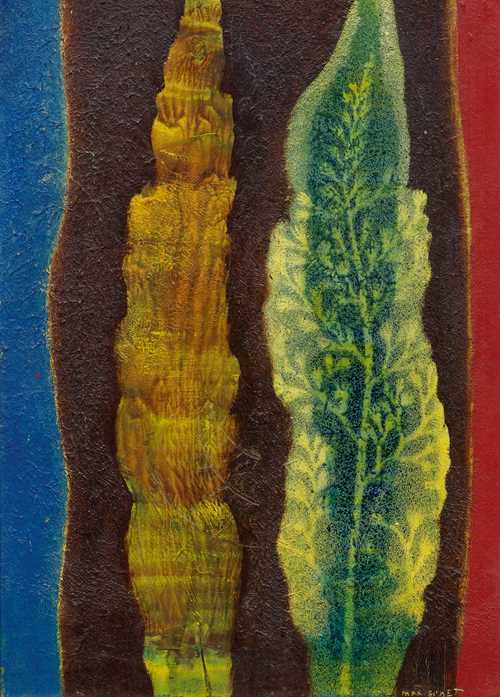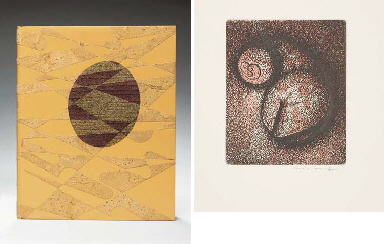Max Ernst Follow Colombe blanche signed and dated ‘max ernst '25’ lower right oil and graphite on canvas 65 x 50.5 cm (25 5/8 x 19 7/8 in.) Painted in 1925.
Provenance Paul Eluard Paris (1938) Roland Penrose London E. L. T. Mesens, London Nierendorf Gallery, New York Frank Perls Gallery, Beverly Hills Burt Kleiner, Beverly Hills Richard Feigen Gallery, New York (acquired from the above in 1970) Galleria Galatea, Turin Andrée Strassart, Paris Paolo Marinotti, Milan Thence by descent to the present owner Exhibited Paris, Galerie Van Leer, Exposition Max Ernst , 10 - 24 March 1926, no. 6 London, The London Gallery, Max Ernst , 15 December 1938 - January 1939, no. 29 San Francisco Museum of Art, 20th Century German Paintings , January 1940, no. 1037 Rome, Museo del Corso, Fondazione Cassa di Risparmio di Roma, Max Ernst e i suoi amici Surrealisti, 24 July - 3 November 2002, p. 29 (illustrated on the cover) Literature Werner Spies, Max Ernst Oeuvre-Katalog Werke 1906 - 1925 , Cologne, 1975, no. 768, p. 400 (illustrated) Catalogue Essay Max Ernst’s Colombe blanche was painted in 1925, at the very dawn of Surrealism. This historic picture features an image of a dove, one of the most important recurring symbols, or indeed characters, in Ernst’s work. Over the coming years, he would add to his avian mythology, creating his own pictorial avatar, Loplop, of which Colombe blanche is a precursor. Sometimes the bird would be caged, or dwarfed by a sinister nocturnal forest; by contrast, in Colombe blanche , the dove appears pale and serene, an image of apparent calm and tranquillity, its wings enfolding itself, depicted as though recalling vine leaves, a blurring of the animal and vegetable worlds that also hints at both Christian and Bacchic imagery. This picture, which is also sometimes known as Colombe d’or , showcases Ernst’s recent development of the frottage technique, with which he would revolutionise the role of painting within the Surreal sphere. This was his method of taking a picture surface—originally paper, and later canvas—and rubbing it against organic materials that would show through, for instance the grain of the wooden planks of a floor, as appears the case in Colombe blanche . These patterns would themselves serve as the springboard for Ernst’s pictorial adventures. Considering the importance of this technique to the incipient Surrealists, it is only too apt that the painting passed through the hands of some of the most important figures of the movement. It was first owned by his friend, the acclaimed poet Paul Eluard an early supporter of the Dada and Surrealist artists whom Ernst had met earlier through the growing international network of authors and artists associated with Dada. Eluard subsequently sold it to Roland Penrose who served as a vital link between Surrealism and the English-speaking world. Colombe blanche also featured in several important early exhibitions of Ernst’s works, including what he recalled as ‘[his] first relatively big show in Paris, at Galerie van Leer. The catalogue, in lieu of the usual sycophantic preface, included poems by Paul Eluard Benjamin Péret and Robert Desnos’ (‘Biographical Notes: Tussie of Truth, Tissue of Lies’, pp. 281-339, Werner Spies, ed., Max Ernst A Retrospective , exh. cat., London, 1991, p. 301). The titular dove in Colombe blanche plugs into Ernst’s personality and indeed persona. Ernst himself claimed that he had had a long-standing confusion in his mind between people and birds, beginning with biographical and mystical experiences in his own youth. These came to inform a number of his paintings over the years, which often saw Ernst represented by a bird within the composition. In that sense, Colombe blanche can be seen as a form of Surreal self-portrait, or at least a projection of the artist’s own state of mind. Certainly, Colombe blanche was created at a vital juncture in Ernst’s life. He had recently signed a contract with Jacques Viot that had allowed him to give up the menial and industrial jobs that had hitherto sustained him, and to dedicate himself to painting. He did so with great relish. On a more persona
Max Ernst Follow Colombe blanche signed and dated ‘max ernst '25’ lower right oil and graphite on canvas 65 x 50.5 cm (25 5/8 x 19 7/8 in.) Painted in 1925.
Provenance Paul Eluard Paris (1938) Roland Penrose London E. L. T. Mesens, London Nierendorf Gallery, New York Frank Perls Gallery, Beverly Hills Burt Kleiner, Beverly Hills Richard Feigen Gallery, New York (acquired from the above in 1970) Galleria Galatea, Turin Andrée Strassart, Paris Paolo Marinotti, Milan Thence by descent to the present owner Exhibited Paris, Galerie Van Leer, Exposition Max Ernst , 10 - 24 March 1926, no. 6 London, The London Gallery, Max Ernst , 15 December 1938 - January 1939, no. 29 San Francisco Museum of Art, 20th Century German Paintings , January 1940, no. 1037 Rome, Museo del Corso, Fondazione Cassa di Risparmio di Roma, Max Ernst e i suoi amici Surrealisti, 24 July - 3 November 2002, p. 29 (illustrated on the cover) Literature Werner Spies, Max Ernst Oeuvre-Katalog Werke 1906 - 1925 , Cologne, 1975, no. 768, p. 400 (illustrated) Catalogue Essay Max Ernst’s Colombe blanche was painted in 1925, at the very dawn of Surrealism. This historic picture features an image of a dove, one of the most important recurring symbols, or indeed characters, in Ernst’s work. Over the coming years, he would add to his avian mythology, creating his own pictorial avatar, Loplop, of which Colombe blanche is a precursor. Sometimes the bird would be caged, or dwarfed by a sinister nocturnal forest; by contrast, in Colombe blanche , the dove appears pale and serene, an image of apparent calm and tranquillity, its wings enfolding itself, depicted as though recalling vine leaves, a blurring of the animal and vegetable worlds that also hints at both Christian and Bacchic imagery. This picture, which is also sometimes known as Colombe d’or , showcases Ernst’s recent development of the frottage technique, with which he would revolutionise the role of painting within the Surreal sphere. This was his method of taking a picture surface—originally paper, and later canvas—and rubbing it against organic materials that would show through, for instance the grain of the wooden planks of a floor, as appears the case in Colombe blanche . These patterns would themselves serve as the springboard for Ernst’s pictorial adventures. Considering the importance of this technique to the incipient Surrealists, it is only too apt that the painting passed through the hands of some of the most important figures of the movement. It was first owned by his friend, the acclaimed poet Paul Eluard an early supporter of the Dada and Surrealist artists whom Ernst had met earlier through the growing international network of authors and artists associated with Dada. Eluard subsequently sold it to Roland Penrose who served as a vital link between Surrealism and the English-speaking world. Colombe blanche also featured in several important early exhibitions of Ernst’s works, including what he recalled as ‘[his] first relatively big show in Paris, at Galerie van Leer. The catalogue, in lieu of the usual sycophantic preface, included poems by Paul Eluard Benjamin Péret and Robert Desnos’ (‘Biographical Notes: Tussie of Truth, Tissue of Lies’, pp. 281-339, Werner Spies, ed., Max Ernst A Retrospective , exh. cat., London, 1991, p. 301). The titular dove in Colombe blanche plugs into Ernst’s personality and indeed persona. Ernst himself claimed that he had had a long-standing confusion in his mind between people and birds, beginning with biographical and mystical experiences in his own youth. These came to inform a number of his paintings over the years, which often saw Ernst represented by a bird within the composition. In that sense, Colombe blanche can be seen as a form of Surreal self-portrait, or at least a projection of the artist’s own state of mind. Certainly, Colombe blanche was created at a vital juncture in Ernst’s life. He had recently signed a contract with Jacques Viot that had allowed him to give up the menial and industrial jobs that had hitherto sustained him, and to dedicate himself to painting. He did so with great relish. On a more persona








.jpg)
.jpg?w=400)





Try LotSearch and its premium features for 7 days - without any costs!
Be notified automatically about new items in upcoming auctions.
Create an alert